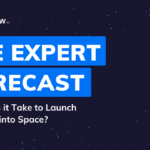What’s the latest and greatest in weather modeling and space?
The innovations happening at Tomorrow.io!
At ClimaCon 4, Tomorrow.io’s space and sensors team provided an in-depth look at the company’s pioneering satellite constellation.
VP of Regulatory & Operations, Kristina Hloptsidis, hosted a panel featuring several key Tomorrow.io team members behind the technology:
- Senior VP Space & Sensors John Springmann
- Senior Atmospheric Data Scientist Joe Munchak
- Principal Scientist, Space & Sensors Ricky Roy
This blog will recap their panel discussion and highlight the space advancements being made at Tomorrow.io.
A Momentous 2023 at Tomorrow.io
The panel kicked off by reflecting on major achievements over the past year.
“It’s been a really exciting twelve months atTomorrow.io, we launched our first satellites. So we’ve got our two pathfinder radar satellites in space Tomorrow R-1 and Tomorrow R-2,” explains John Springmann.
Getting the satellites operational was no small feat. “Anytime that you have a first satellite of its kind, going through assembly, there’s lots of surprises,” said Roy. “But currently they’re operating really well in steady state radar operations.”
Springmann explained that the last year was filled with critical milestones: “Twelve months ago, we didn’t even have anything in space or in the final throes of assembly integration and test. Launch, establish initial communications. So that’s probably one of the most nerve wracking moments. You wanna make sure your satellite, obviously survived the launch and turns on, you can communicate with it.”
Overcoming Key Challenges
This exciting year has come with its challenges.
As Springmann noted, “Spacecraft development is really complex. It’s very multidisciplinary. All sorts of technical challenges, logistical challenges, the regulatory challenges, right, the breadth of things we deal with. It’s quite wide.”
Roy pointed to complications with the radar payload itself: “There are quite a few challenges that just arise from the fact that it’s such a complex instrument. And that’s because it’s such a demanding measurement.”
According to the panelists, the team’s experience and agile approach were instrumental in getting the satellites operational on a short timeline.
As Springmann put it, “A combination, I think, of really the team we put together just our development approach. We’ve been able to get these awesome satellites launched within a couple of years.”
Biggest Successes So Far
Despite these challenges, Tomorrow.io has seen significant successes throughout the course.
Springmann pointed to the quality of data being collected: “I think the biggest success is bringing our radar measurements down. Our radar payload is performing really well, to make sure Ricky can add as the notes on to.”
Roy expanded on getting actionable data from the payloads: “One of the the major successes with was the the speed with which we were able to derive calibrated radar data, which is really key to being able to utilize that data for applications and estimating precipitation and other other geophysical areas.”
He continued, “Specifically the very first observations that we took, there’s a lot of onboard processing and software that’s necessary in order to even be able to measure the atmosphere with these radars…And on the very very first try, we were actually perfectly successful. We timed it to within a fraction of a microsecond. And that was very exciting to see those returns exactly where we expect them.”
What makes Tomorrow.io’s satellite program unique?
As Springmann explained, “A key thing is why.
What problem are we trying to solve? And the reason that we are developing these precipitation radars, and also passive microwave sounders, is to fill in a specific gap in collecting weather observations around the world.”
He continued, “Now contrast that with kind of stumbling upon technology or leveraging technology that has become, you know, smaller, cheaper, lower power in some way easier to operate in space. There’s many space approaches that kind of start that way and then evolve along a technical road map associated with the technology. But for us, it’s really, starting from that perspective of how we make forecast better, and then coming to, oh, we need radars.”
Insights Revealed by New Satellite Data
On the insights gathered from the satellites so far, Roy shared: “We’ve been really pleased by the response both, to our presentations as well as to the data products themselves. People are really digging into it, comparing it with other ground based sensors, for instance, and in really revealing the quality of the really high science quality of the measurements that we’re making.”
He added, “People have been launching microwave instruments into space for many, many decades now, but these sorts of active transceivers that make up radars like this and specifically at these very high frequencies are extremely challenging. And so that drives a lot of issues that come up in assembly integration and tests that you need to be able to troubleshoot very quickly.”
Improving Weather and Climate Forecasting Worldwide
Munchak explained how the satellite data will significantly enhance weather forecasts: “We’re going to have more of that [data] than anyone else with this constellation taking these high resolution precipitation measurements. So we’re looking to actually develop some of these techniques that can utilize all this data and provide very accurate short term precipitation forecasts, at hyper local scales all over the world.”
He continued, “There really is only being done now in areas with these dense ground radar networks, which only a few countries have. So it’s about how do we bring that type of observational capability to the whole world?”
On the climate front, Roy noted: “I think one of the things I was most excited about joining the company is that these observations in addition to being useful for the short term and medium range weather forecasting applications would be really critically useful for the science community, for furthering the aims of climate science.”
Helping Businesses Worldwide Assess Weather Risk
When it comes to helping customers mitigate weather risk, Springmann said: “Really the purpose of our satellites is to collect these really unique observations globally, really low latency, high revisit rate.
Have those observations feed into our weather models and actually enable much better forecasts over both kinda near and medium term time ranges.”
He continued, “And that will ultimately improve that downstream weather intelligence that we provide to our customers.”
Making the World Safer Through Early Weather Warnings
On how the satellites make the world safer, Roy explained: “Any observations that can get at these systems will improve their forecast, especially as we’re gonna have more of them and improve forecasting methodologies. So I think really, it’s about enhancing the ability of local governments, and other end users of our data to get that early warning for those events and take preparations.”
He gives an example: “We have a very exciting collaboration with the nonprofit arm of the company tomorrow now dot org and the Bill and Melinda Gates Foundation to actually demonstrate some of these capabilities, in Kenya. Where specifically there is a well known lack of ground radar coverage and a lot of severe storms that occur.”
Major Plans for Expanding the Constellation
The team is not resting on its laurels.
Major plans for 2023-2024 include:
- Launching passive microwave sounders starting in early 2024
- Operationalizing the pathfinder satellites
- Launching new scanning radar satellites by end of 2024
As Springmann summarized: “So all sorts of things. And that’s just on the space side. I didn’t even mention everything that has to happen on the ground side with that. So data processing mission operation etcetera. So, it’s gonna be quite the next twelve months, as usual. Right. Yeah. Never a dull moment.”
“Big things to come!” says Springmann.
Tomorrow.io’s satellite constellation is rapidly expanding and promises to provide invaluable insights that will revolutionize weather intelligence worldwide.
The team is committed to pushing boundaries and overcoming obstacles to achieve their bold vision.
Learn more about this exciting journey at ClimaCon 4, available for on-demand viewing.



